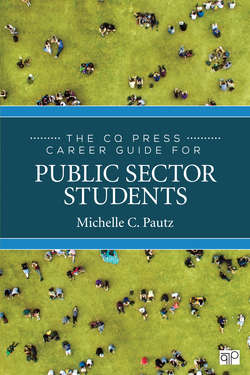The CQ Press Career Guide for Public Sector Students

Реклама. ООО «ЛитРес», ИНН: 7719571260.
Оглавление
Michelle C. Pautz. The CQ Press Career Guide for Public Sector Students
The CQ Press Career Guide for Public Sector Students
Contents
Preface. Introduction
Why I Study Public Administration and Do What I Do
Acknowledgments
About the Authors
Chapter One Defining the Public Sector and Its Opportunities
What Is the Public Sector?
Application Activity
Perceptions and Myths About the Public Sector
Application Activity
Public Sector Misconceptions
Application Activity
Chapter Wrap-Up
Action Items
Public Sector Profile
Chapter Two Curriculum Considerations
Selecting Academic Programs, Majors, and Minors
Application Activity
Picking Courses
Application Activity
Using Your Course Assignments and Activities
Application Activity
Chapter Wrap-Up
Action Items
Public Sector Profile
Chapter Three Co-Curricular Opportunities and Experiences
What Are Co-Curricular Opportunities and Experiences?
Application Activity
Pursuing Co-Curricular Experiences
Application Activity
Reflecting on Successful and Less Successful Co-Curricular Experiences
Chapter Wrap-Up
Action Items
Public Sector Profile
Chapter Four Finding Your Passion and Pursuing It
Finding Your Passions
Application Activity
Learning Beyond College
Application Activity
Summary Insights
Chapter Wrap-Up
Action Items
Public Sector Profiles
Chapter 1
Chapter 2
Chapter 3
Chapter 4
Отрывок из книги
As we look at the world around us, no matter where we identify ourselves politically or what issues we prioritize, there are changes we would all like to see in society and government. And more often than not, those changes are actioned by the individuals who work in the public sector. Over the years, as I work with undergraduate and graduate students, I find constant inspiration in those students and their desires to make the world a better place. And in conversations with these individuals, I am regularly reminded how intimidating the public sector can appear from the outside, how confusing it seems, and how hard it is to navigate those initial professional steps in public service. Accordingly, this guide captures the themes of so many of those conversations that I have with students as they sought to serve the public in a range of capacities. I offer no assurances that this guide will help you instantly figure it all out (indeed, I still have much to figure out!), but what I hope this guide will do is help you demystify the public sector, think seriously about a career in it, and engage in some activities that will help you figure it out.
I am deeply appreciative of all the students who have allowed me to walk with them during parts of their journey to finding meaningful and fulfilling work in the public sector and to chip away at the problems they see around us. These students and all the public servants motivate me and inspire me daily.
.....
These conflicted attitudes are nothing new. American history reminds us how much colonists and the nation’s first citizens distrusted the British monarchy, and we know what colonists thought of taxes. While disdain for the public sector is commonplace in the United States, there have been fluctuations over time. Believe it or not, there was a time in America’s history when working in the public sector was thought of as noble and prestigious—something parents wanted for their sons (this was during the early years of the nation, and it was typically only men who worked outside of their home).
But since the latter part of the 20th century through today, we see downward trends in Americans’ attitudes about government (with the notable exception of the aftermath of the terrorist attacks of September 11). Public trust in the federal government continues to hover at near all-time lows, with only 18 percent of Americans saying they can trust government to do what is right (Pew Research Center 2017). These negative attitudes about the public sector might help explain that while 94 percent of millennials want to use their skills to be of service and benefit a social cause, only 7 percent of the federal government workforce is under the age of 30 (Curry 2017).
.....